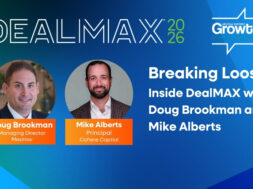The Swinging Pendulum of ESG Priorities
In today’s polarized political environment, private equity professionals are taking cues from LPs on ESG strategy—and figuring out the right balance between values and value creation in the process

How is the middle market approaching ESG?
It depends on whom you ask.
In an increasingly politicized environment, especially in the U.S., the perspective on environmental, social and governance factors varies greatly.
For private market firms, ESG commitment largely follows the direction of limited partners. “If LPs cared that we needed to get Swiss cheese from the moon, we’d all be building rockets and carving cheese out. The LP community has become more varied in terms of how it feels about ESG issues,” noted Aaron Miller, partner at Apollo Global Management, during a panel on value creation at ACG’s DealMAX conference. “I think we’re on a pendulum. The pendulum swings back and forth based on events. I think it will settle itself out.”
The LP community has become more varied in terms of how it feels about ESG issues.
Aaron Miller
Apollo Global Management
When it comes to climate concerns, some LPs have made net-zero commitments, while others are aligned with laws like Oklahoma’s Energy Discrimination Elimination Act that prohibit firms from factoring ESG issues into their investment decisions. Policies among pension funds illustrate this spread. Some, like the $31.4 billion Los Angeles Fire & Police Pension, are “fully committed to ESG,” and others, like the $344 million Anchorage Police and Fire Retirement System, do not consider or plan to consider ESG, according to an article in Pensions & Investments.
In a 2022 joint survey of over 100 LP organizations by the Institutional Limited Partner Association and Bain & Co., 70% of respondents said that ESG considerations play a role in organizational PE investment policies, and around 85% incorporate at least some ESG initiatives. However, fewer LPs in the U.S. than Europe report having an ESG policy (62% of those with headquarters in North America, vs. 83% in Europe).
In terms of diversity, equity and inclusion (DEI), one of the components of ESG, some observers are seeing flagging interest four years after the widespread protests—and corporate pledges—that followed the 2020 murder of George Floyd. “[DEI] was something that everybody was talking about five years ago, and now it’s not an area of focus,” said Donna JW Hare, senior business performance consultant at Insperity, during another ACG DealMAX panel.
Still, some data suggests increased interest from LPs when it comes to DEI metrics, which has in turn encouraged more systematic reporting from private equity firms. According to a 2023 McKinsey report, “Institutional investors are now broadening their view of DEI beyond the investment team and institutional investors increasingly ask about DEI metrics at portfolio companies and their boards.” Some LPs report requiring minimum thresholds on DEI metrics before considering an investment.
According to McKinsey, private equity firms improved their representation of women by 2% and their representation of ethnic and racial minorities by 1% over the prior year. But there’s a wide gap between leading and lagging firms. At leading firms, an average of 42% of investment professionals identify as ethnic and racial minorities. Lagging firms, meanwhile, “have almost no ethnic and racial diversity at senior levels,” and only 23% of the overall talent pool identifies as ethnic and racial minorities.
A 2024 report by Honordex—which scores PE firms on their DEI performance, proportional representation of leadership teams, social media support for DEI, and statements of commitment across company materials—found that the average DEI score for PE firms increased this year, but that the industry as a whole remains at an average “intermediate” level.
The Mid-Market Landscape
How do limited partners’ attitudes translate into general partners’ approaches to ESG?
Anecdotal feedback suggests a wide range of approaches—from those who “have religion around ESG,” with systematic reporting processes designed to create value and attract like-minded LPs, to those who “don’t care about ESG, don’t think ESG makes them money, have enough LPs who don’t care about ESG and don’t want to talk about it,” says Vinay Shandal, managing director and senior partner at Boston Consulting Group.
In between those two extremes is a larger group that is on the fence about the value of ESG. Perhaps some of those ESG-curious PE firms are considering net-zero commitments or have LPs who have already made them. Many recognize that even if ESG isn’t a part of their process now, it may need to be in the future.
Outside of these three buckets, there are also middle-market investors with climate-focused funds who don’t necessarily fixate on ESG criteria any more or less than other firms—but who do see an opportunity to put capital to work in the climate economy to generate returns.
“Right now, especially in the mid-market, there’s room for all of these perspectives,” says Shandal. “But the direction of travel is clear. Both sides of the aisle recognize temperatures are rising and that we have more physical damage as a result of the climate. And even if your LPs still don’t care, the people you exit to very well may.”
Value Over Values
In general, it can be difficult to have a nuanced conversation about ESG given the broadness of the acronym. “Those three letters embody so many things that are not necessarily related,” says Shandal. “A company can be really good at climate and really bad at diversity.”
This lack of specificity, combined with increased politicization, has led some pension funds to avoid using the term “ESG” entirely. For example, CalPERS, the largest public pension fund in the U.S., recently replaced the acronym with the term “sustainable investment,” according to Pensions & Investments.
For dealmakers looking to cut through the political noise, one approach is to focus on how ESG strategies create value, rather than the moral arguments for such strategies. “When we talk about private enterprise as a vehicle for affecting public policy, then the role of private enterprise starts to be confused,” says Shandal. “But if we can agree that private enterprise exists to create value, and we focus on ESG factors—whether it’s climate or employee safety or diversity—because they unlock value, that’s apolitical. As long as the conversation remains centered on value vs. values, everything’s fine.”
If we can agree that private enterprise exists to create value, and we focus on ESG factors—whether it’s climate or employee safety or diversity—because they unlock value, that’s apolitical. As long as the conversation remains centered on value vs. values, everything’s fine
Vinay Shandal
Boston Consulting Group
Indeed, ESG has been shown to have a positive correlation with financial returns. According to a report from New York University’s Stern Center for Sustainable Business and Rockefeller Asset Management, which aggregated over 1,000 studies on ESG from 2015-2020, 58% of the corporate studies showed a positive relationship between ESG and financial performance. A 2020 McKinsey report found that companies with more ethnically or racially diverse teams are 36% more likely to outperform less-diverse management teams, while businesses with more gender diversity on their leadership teams are 25% more likely to financially outperform those with less gender diversity.
While such statistics are promising, some in the industry note a lack of comprehensive data and performance standards as a roadblock when it comes to proving ESG’s impact on financial performance. And even as some firms believe in ESG as a core value driver, others may incorporate it into investment processes primarily to manage risk or protect their reputations.
Others think of it primarily as a marketing tool. “Greenwashing is still a consideration that investors have to think about,” says Matt Schey, managing director of external affairs and sustainable investing at the Institutional Limited Partners Association (ILPA).
In the European Union, more stringent reporting requirements around ESG, notably the Corporate Sustainability Reporting Directive, have been developed to help combat and prevent greenwashing. While the U.S. landscape is less aligned around ESG initiatives, there have been some similar attempts, including the Security and Exchange Commission’s climate disclosure regulations and California’s climate disclosure laws.
“The most effective way to talk about how you evaluate ESG risks and opportunities with your investors is to be able to clearly show which considerations are material to your business and strategy and how that contributes to driving returns,” says Schey.
Investors today are asking tougher questions than they might have four years ago. “GPs should be explicit when discussing ESG considerations, specifically focusing on the criteria they deem material and how those considerations factor into or inform their investment strategy,” Schey adds.
How to Incorporate ESG
There are a growing number of resources for firms looking to create ESG policies or incorporate more ESG considerations into their investment processes. The ESG Data Convergence Initiative seeks “to overcome the disparate constellation of ESG performance assessment frameworks and tools in the private equity industry.” ILPA provides resources including an ESG Assessment Framework and a decarbonization handbook, both of which can be helpful for private market firms looking to gain more insight into the LP perspective.
For middle-market firms, the process of developing an ESG strategy can be an exercise in not letting perfect be the enemy of good.
Lower middle-market private investment firm IMB Partners learned this lesson while developing its responsible investing policy. “The ‘S’ in ESG has always been core to our work, and we have a track record of prioritizing DEI work in the management of our portfolio companies,” says Lenora Robinson Mills, COO of IMB Partners. At the firm’s inception, “IMB” stood for “Investing in Minority Businesses.” But until 2023, the firm didn’t have a structured ESG framework.
At that time, IMB shifted from an independent sponsor model to investing through its funds and reporting to institutional LPs—a move that necessitated a focus on ESG, at least in part because of the firm’s unique characteristics. “We’re often categorized as an emerging fund and we’re an African-American-owned firm. Those two categories tend to attract LPs who prioritize ESG,” says Mills.
The process of drafting a responsible investing policy, which involved engaging outside consultants and extensive dialogues with IMB’s portfolio companies, first resulted in a “20-page policy that was very repetitive and didn’t speak to the culture of our firm and our industry,” says Mills.
Distilling that policy into something more meaningful and representative of IMB required accepting that the firm wouldn’t be able to cover everything. “ESG is just so big. It was important for us to make sure that our approach to it was still centered on our values as a firm. It’s easy to say other firms do this or that, but at the starting point, we wanted to make sure our policy was digestible, manageable and actionable,” says Mills.
For firms looking to create policies and systems of their own, authenticity is key. Firms should think about what components of ESG make most sense for them to focus on. “It’s about picking a few things you want to ask about systematically for every company. What are the 10 or 15 things buried under the E, S or G acronyms that are most relevant to your business?” says Boston Consulting Group’s Shandal. “There are some criteria, like diversity, that will be relevant for almost everyone. Unless you’re a one-person shop working with robots, it’s a thing that’s consistently been shown to produce better results. But maybe climate isn’t applicable for businesses with tiny footprints.”
Though incorporating ESG may seem overwhelming, ultimately, it’s a task PE firms are well-equipped to excel at. “Creating an ESG playbook should be no different than creating a playbook for other value-creation issues,” says Shandal.
Meghan Daniels is a freelance writer and editor based in Dutchess County, New York.
Middle Market Growth is produced by the Association for Corporate Growth. To learn more about the organization and how to become a member, visit www.acg.org.


